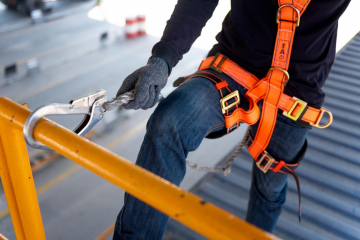A good mantra for EHS leaders: what would Homer Simpson NOT do? We review his track record for workplace health and safety in search of takeaways.
Some people are perfectly suited for their careers — almost as if they were born to do the job. I think it’s fair to say the exact opposite is true of Homer Jay Simpson.
America’s most lovable animated doofus, and star of The Simpsons for three decades running, serves as Safety Inspector in Sector 7G at the Springfield Nuclear Power Plant. Homer’s antics provide a master class in what not to do in settings where safety is paramount. Although he was once described by a misguided activist as “the man whose very name is synonymous with safety,” any fan of the show knows this is egregiously untrue. Homer has been the cause of, and solution to, many of the Springfield’s gravest mishaps.
But sometimes, worst practices can be just as instructive as best practices. And no one exemplifies the former more than Homer. So join us for a trip to Evergreen Terrace as we celebrate the longest-running comedy in TV history by extracting workplace health and safety lessons from the plucky patriarch’s escapades.
Environment, Health, and Safety Worst Practices, Courtesy of Homer Simpson
1. Beware of Distractions (D’oh!)
It’s been over 30 years since “Homer’s Odyssey,” the third episode of The Simpsons’ inaugural season, first aired on Jan. 1, 1990, and we learned about how Homer originally landed in his position as Nuclear Safety Inspector.
As you may recall, Homer lost his original job as a Technical Supervisor at the power plant when he crashed an electric cart into a cooling vent while waving at his son Bart, who was on hand with classmates for a school field trip.
Subsequently, an unemployed Homer becomes a crusader for public safety, and is later hired back at the plant as a Safety Inspector — despite his admission to owner C. Montgomery Burns that “if truth be known, I actually caused more accidents around here than any other employee.”
This fact owes mostly to a general obliviousness, which was on display in the aforementioned crash incident. Despite the vital importance of his job, Homer is all-too-easily distracted by everything from daydreams to donuts. As an EHS leader, maintaining focus and cutting out distractions is essential to effectively managing and mitigating risk.
Among the steps you can take to diminish distractions in your workplace: emphasizing industrial hygiene and addressing commonly overlooked EHS risks.
2. Mmm… Preparation
Who could forget about the time that reps from the Nuclear Regulatory Commission showed up for a surprise safety inspection in Springfield? It’s fair to say the power plant’s administration was caught a bit off-guard:
To their credit, Mr. Burns and cohort Mr. Smithers did “prepare” for such a visit by hiding Homer (along with two other incompetent employees) in the plant’s basement, tasked with watching a bee in a jar. But of course that doesn’t stop Homer from showing up and failing so badly during his evaluation that he manages to cause a meltdown in a simulator with no nuclear materials.
I’d argue the better safeguard would be to ensure Sector 7G’s Safety Inspector himself was actually prepared and poised to handle such a scenario. Homer’s strategy of covering his eyes and blindly pressing buttons suggests he probably could’ve been better trained to step up in the big moment.
Obviously, it’s helpful to have a basic understanding of one’s core job duties. But beyond that, there are steps that even a far more competent EHS leader can take to be ready for, say, an EHS audit or any unforeseen situation that might emerge. Comprehensive emergency response planning and extensive documentation will help you and your team confidently handle anything that comes your way.
3. All Work and No Sleep Makes Homer Something Something
As you likely noticed at the beginning of the last clip, one of Homer’s favorite activities at work is sleeping, and it tends to create some problems.
I’m sure we can all relate to feeling drowsy at work from time to time, but when it becomes a regular thing it can take a toll on our cognition and reactiveness. It’s critical for EHS leaders to be alert and aware.
Sure, coffee helps, but there’s no replacement for consistently getting a good night’s sleep. Aim to do so, and emphasize this focus for employees as part of your wellness initiatives. When schedules and habits are thrown off by changes like daylight savings, it’s especially valuable to make people conscious of this silent inhibitor.
4. Prank Responsibly and Plan Rigorously
We love office pranks. Safe, good-natured gags can be a great way to share a laugh and build comradery with your colleagues.
Talking about pranks highlights another key item in EHS safety planning: emergency exit access. According to OSHA requirements, workplaces should have at least two exits that are clearly visible and free of hazards/obstructions. They should also be, you know, real and not painted onto a wall.
5. Collaborate with Your Cast of Characters
Among the many practical inaccuracies in The Simpsons’ depiction of a nuclear power plant: control room operators like Homer do not work by themselves. (Also: “Fuel rods are not used as paper weights.”)
Safety is never a one-person job. Work to market your program internally, engaging and activating employees around crucial safety concerns. Seek also to loop in the C-suite and enlist company leaders as vocal advocates for your cause, as their voices can make a big difference when it comes to driving participation and buy-in. Chances are, your boss is a little more kind-hearted and compassionate than this guy:
Workplace Health and Safety Is No Joke
Whether you work in a high-risk facility like the Springfield Nuclear Power Plant, or a low-risk facility like the Kwik-E-Mart, workplace health and safety should be a preeminent consideration. Homer Simpson’s hilarious mishaps over the past 30 years have provided plenty of fodder for EHS worst practices.
Through vigilant oversight and team activation, you can steer clear of the constant hazards triggered by Homer in Sector 7G. Woo-hoo!
Want to find more workplace health and safety lessons drawn from a timeless 30-year-old comedy classic? Check out our writeup on avoiding EHS hazards with help from Christmas Vacation’s Clark Griswold.
Want more news and insights like this?
Sign up for our monthly e-newsletter, The New Leaf. Our goal is to keep you updated, educated, and even a bit entertained as it relates to all things EHS and sustainability.
Get e-NewsletterHave any questions?
Contact us to discuss your environment, health, safety and sustainability needs today.









